 |
|||||||||||||||||||||||||||||||||||||||||||
|
“I hunted curious flowers in rapture
and muttered thoughts in their praise. . . I knew nothing of poety. It was felt not uttered.”
|
|||||||||||||||||||||||||||||||||||||||||||
|
 Like everyone else, I’ve come to be awed. This Sunday morning, I’m standing in line waiting to get inside the greenhouse where Titan is blooming. The president of the botanical garden called Titan “one of the world’s most iconic plants.” He said the flower was an “important symbol of the incredible diversity of the world’s plants which we all need to work to conserve in cultivation and in their natural habitats.” Titan's natural habitat is a slice of land in southwestern Sumatra, Indonesia. The coverage of Titan’s flowering in our local newspaper didn’t bring up conservation of endanger habitants at all but instead preferred to deal with the flower’s rarity, gigantic size, and its smell which the article used words like rotten, foul, and stench to describe. I arrived at the botanical garden shortly after it opened this morning. The parking lot was nearly full and the line waiting to see Titan stretched the length of the entry plaza to the greenhouse. Naturally everyone had a camera and naturally most of the line talk was about the flower’s smell. Since few of us had ever seen a Corpse Flower in bloom, each one of us was wondering how we would react when we got to the front of the line. I must have heard variations on the theme “I hope I don’t gag” a half-dozen times. I noticed when visitors got to the front of the line they took two kinds of pictures. First, they took pictures of Titan from lots of different angles. Then they took pictures of kids, family, friends, and themselves posing with Titan as a backdrop. Kids had fun grimacing and pinching their noses as they posed. But I saw no one hurrying out with their hands covering their months or noses. 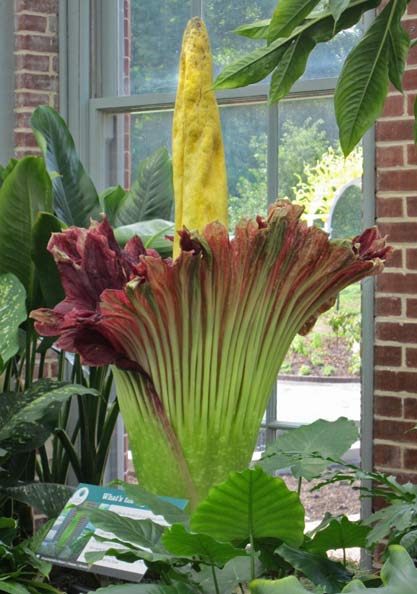 When I finally got to the front of the line, I also wondered where the much advertised smell was. The flower was indeed exotic and imposing to see, but there was barely a whiff of anything close to nauseous. The slight odor that I could detect was no worse than some raw onions or a few broccoli leaves left in a kitchen waste can a day too long. Am I reasonable to feel cheated because I didn’t feel sick? Still, I left thinking what I heard other visitors saying, “It’s a once in a lifetime experience.” 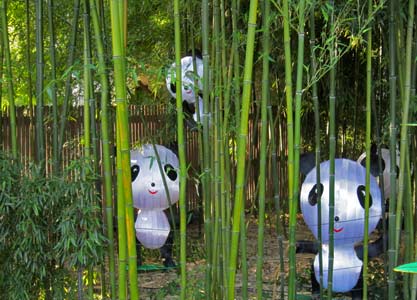 The artists are assembling the last few lanterns for the grand opening of the Chinese Lantern Festival next weekend. Because record crowds are expected for the Festival opening, the gate keeper told me that the Garden will be closed to early walkers like me next Saturday. These happy panda lanterns were put in place sometime during the week. Fittingly, they’ve been tucked in and around the Garden’s large stand of tall yellow-groove bamboo (Phyllostachys aureosulcata). 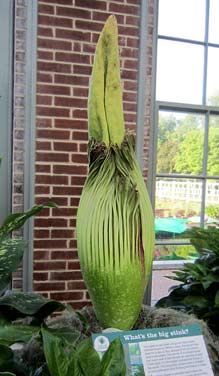 When will the Corpse Flower (Amorphophallus titanum) bloom? When will the Corpse Flower (Amorphophallus titanum) bloom? I asked the keeper of the greenhouse who happened to be watering the house when I arrived what he thought. He said that earlier this morning he gently pried open the spathe wrapper a bit and saw that the flower’s characteristic black-purple inner color was fully developed. That means it’s ready, he said. He thinks it will bloom tonight. “It seems fitting that a Corpse Flower would prefer to open at night,” he said. He added that if it does bloom tonight, he’s going to have tough day working in the greenhouse tomorrow because of Titan’s trademark putrefying smell. I asked the keeper of the greenhouse who happened to be watering the house when I arrived what he thought. He said that earlier this morning he gently pried open the spathe wrapper a bit and saw that the flower’s characteristic black-purple inner color was fully developed. That means it’s ready, he said. He thinks it will bloom tonight. “It seems fitting that a Corpse Flower would prefer to open at night,” he said. He added that if it does bloom tonight, he’s going to have tough day working in the greenhouse tomorrow because of Titan’s trademark putrefying smell. Nobody I know talks about “lifestyle plants.” I came across the odd term on a seed seller’s web site. I was there looking for more information about a very large, striking coleus that I saw this morning at the botanical garden. The coleus named ‘Kong Green’ has been planted in large container pots in the Garden’s entrance atrium. ‘Kong Green’ has leaves as wide and expansive as a cabbage. Just a few of them could fill a large container. Nobody I know talks about “lifestyle plants.” I came across the odd term on a seed seller’s web site. I was there looking for more information about a very large, striking coleus that I saw this morning at the botanical garden. The coleus named ‘Kong Green’ has been planted in large container pots in the Garden’s entrance atrium. ‘Kong Green’ has leaves as wide and expansive as a cabbage. Just a few of them could fill a large container.So back to “lifestyle plants.” Harris Seed Company says that to people who sell plants, a lifestyle plant is a plant that's “a complete package;” “a ready-to-go item.” It’s a stylish, perfect-looking plant that the seller has transplanted into stylish-looking pot all set for the buyer to take home with no-fuss, no-muss. A lifestyle plant has to look stunning in the buyer’s home or office or outside on his or her patio or deck for at least 21 days. Then the seller hopes the buyer will throw out the old lifestyle plant and pot and buy another fresh new stylish, perfect-looking plant and a new pot to match. The ‘Kongs’ are spectacular, but these as “lifestyle plants,” it's been designed to perish. 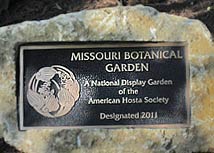 I noticed this prominent stone marker with a plaque attached at the entrance to hosta walk. The plaque names the botanical garden as a national display garden of the American Hosta Society. Among other things, the Society requires that a national display garden have at least 100 different named and labeled hosta varieties. No trouble here. I counted 330 named varieties on the Garden’s plant datebase and a total of 652 hostas of all kinds planted throughout the botanical garden. I noticed this prominent stone marker with a plaque attached at the entrance to hosta walk. The plaque names the botanical garden as a national display garden of the American Hosta Society. Among other things, the Society requires that a national display garden have at least 100 different named and labeled hosta varieties. No trouble here. I counted 330 named varieties on the Garden’s plant datebase and a total of 652 hostas of all kinds planted throughout the botanical garden.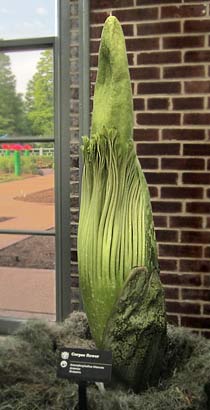 A first –a Corpse Flower is set to bloom in this botanical garden. I’ve been told that in the 150+ years since the garden was founded, it has never happened before. Among flowers, the Amorphophallus titanum is celebrated for its repulsiveness. A Corpse Flower is like a sideshow at a carni – so bizarre and so revolting that people are willing to pay money to see it. A first –a Corpse Flower is set to bloom in this botanical garden. I’ve been told that in the 150+ years since the garden was founded, it has never happened before. Among flowers, the Amorphophallus titanum is celebrated for its repulsiveness. A Corpse Flower is like a sideshow at a carni – so bizarre and so revolting that people are willing to pay money to see it.To understand the allure of the flower, start with its botanical name. Translated from the Latin, the plant’s botanical name means gigantic misshaped penis. Then there’s the plant’s exotic appeal that comes with growing on the other side of the world in the wetlands of Sumatra and with the fussiness, time, and uncertainty of trying to coax Titanum to bloom. But above all else, it’s the smell. Most describe the flower as smelling like rotting flesh. More imaginatively, one eyewitness describes the plant's odor as “reminiscent of long–dead rat with just a hint of brie.” Another compares it to what “Hannibal Lecter's compost pile would smell like on a hot August.” 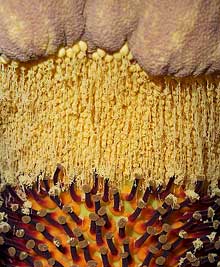 Titan has been moved from the garden’s greenhouses that are off-limits to a public greenhouse where visitors can track its progress from bud to bloom. I was told that the bud is perhaps four to six days away from flowering and that its road to blooming is being continuous recorded by a time lapse camera. When the bud does open, the flower will last just one to three days. Its flowering structure will have a large deep-purple ruffled skirt called a spathe. Poking out from the spathe will be a tall pillar called the spadix. The actual flowers are near the base of spadix – a band of yellow male flowers above a band of orange and black female ones. People who have studied the blooms found that the odor is at its worst when the female flowers are ready to be pollinated and then again when the males shed their pollen. Female flowers are receptive to pollen for just one night. The male flowers wait to produce their pollen the following day so that the plants can’t pollinate themselves. I plan to revisit the Corpse Flower in a few days to see whether I can get in on any of the drama. Titan has been moved from the garden’s greenhouses that are off-limits to a public greenhouse where visitors can track its progress from bud to bloom. I was told that the bud is perhaps four to six days away from flowering and that its road to blooming is being continuous recorded by a time lapse camera. When the bud does open, the flower will last just one to three days. Its flowering structure will have a large deep-purple ruffled skirt called a spathe. Poking out from the spathe will be a tall pillar called the spadix. The actual flowers are near the base of spadix – a band of yellow male flowers above a band of orange and black female ones. People who have studied the blooms found that the odor is at its worst when the female flowers are ready to be pollinated and then again when the males shed their pollen. Female flowers are receptive to pollen for just one night. The male flowers wait to produce their pollen the following day so that the plants can’t pollinate themselves. I plan to revisit the Corpse Flower in a few days to see whether I can get in on any of the drama.The first Amorphophallus titanum ever to bloom in the United States was at the New York Botanical Garden in the summer of 1937. Perhaps to commemorate that first bloom, there’s a full-sized sculpture of an Amorphophallus done in bronze by New York artist Tom Otterman outside the entrance to one of the Garden’s greenhouses. The piece shows the flower in four phases as it moves from bud through decay. At each stage the flower’s natural pollinators, dung beetles, are crawling on, in, or near the flower.  A lantern made to resemble a Chinese junk boat that will complete with two square masts and a dragon’s head bow is being put up in the pond at the base of the dry stream garden. As with most of the lanterns being installed for the upcoming Lantern Festival, the boat was made by stretching silk fabric over a wire frame.  The surprise and delight comes by looking closely at the what the artists have attached to the fabric. The whole boat including the sails, looks as though it’s been made of plastic water bottles. We saw a gallon container of adhensive nearby that the artists are using to fasten the bottles to the cloth. The surprise and delight comes by looking closely at the what the artists have attached to the fabric. The whole boat including the sails, looks as though it’s been made of plastic water bottles. We saw a gallon container of adhensive nearby that the artists are using to fasten the bottles to the cloth. I never paid much attention to larkspurs. When I was growing up they were just there – About this time they put up tall stocks lined with small blue flowers. Then they seeded and next year they did it all over again. Things have changed. Look at this one called ‘Misty Mauve’ blooming in Gatehouse garden -- double blooms so big that they fill all the open spaces along the stocks. Most impressive though is the bi-color – hyacinth-colored petals at the front neatly offset by blue ones in back. I found that ‘Misty Mauve’ was developed by a delphinium nursery in New Zealand that has passion for “producing strong, reliable, healthy, supremely impressive delphiniums that will out perform and outlive their rivals.” Our hot Midwest summers tend to turn perennials like larkspurs into annuals so I’ll be watching to see if ‘Misty Mauve’ returns next year. I never paid much attention to larkspurs. When I was growing up they were just there – About this time they put up tall stocks lined with small blue flowers. Then they seeded and next year they did it all over again. Things have changed. Look at this one called ‘Misty Mauve’ blooming in Gatehouse garden -- double blooms so big that they fill all the open spaces along the stocks. Most impressive though is the bi-color – hyacinth-colored petals at the front neatly offset by blue ones in back. I found that ‘Misty Mauve’ was developed by a delphinium nursery in New Zealand that has passion for “producing strong, reliable, healthy, supremely impressive delphiniums that will out perform and outlive their rivals.” Our hot Midwest summers tend to turn perennials like larkspurs into annuals so I’ll be watching to see if ‘Misty Mauve’ returns next year. Less than three weeks before the Chinese Lantern Festival opens at the botanical garden. Each week we see more lanterns being installed and finishing touches being put to others. This morning we were able to get close enough to some of the larger lanterns to see some of the detail. Most are made of silk material stretched over metal frames.  Two though used other materials. An enormous dragon that stretches over three reflecting ponds has porcelain plates for scales, a tail made of teacups, and serving plates and spoon soups added just for fun. A pair of dragon horses are made entirely of small glass bottles filled with water tinted in shades of yellow, green, and blue. Two though used other materials. An enormous dragon that stretches over three reflecting ponds has porcelain plates for scales, a tail made of teacups, and serving plates and spoon soups added just for fun. A pair of dragon horses are made entirely of small glass bottles filled with water tinted in shades of yellow, green, and blue.  A blog written by a manager of a Chinese company that designs and makes lanterns for festivals all over the world says that he’s getting more calls for lanterns made from unusual materials like the two I saw this morning. On his blog he’s posted a temple lantern made from neon lights shaped into intricate decorative designs, a Buddha lantern made from colored fiberglass rods, and a lantern of a phoenix that uses compact discs. He says his company has also fashioned lanterns made of silkworm cocoons, table tennis balls, flashlights, and red peppers. The festival at this botanical garden is billed as one that will adhere to traditional Chinese cultural themes, so I’d be surprised if I see lanterns made from cd’s or neon. 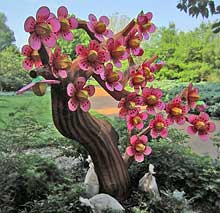 A few simple graceful lanterns are being setup in the botanical garden’s Chinese Scholar’s Garden. Around the pond is a display of lotus lanterns. At the entrance walk to the garden there are several of these cherry blossom trees with stamens painted on silk petals. A few simple graceful lanterns are being setup in the botanical garden’s Chinese Scholar’s Garden. Around the pond is a display of lotus lanterns. At the entrance walk to the garden there are several of these cherry blossom trees with stamens painted on silk petals.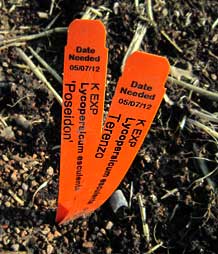 I’m no longer growing my own tomatoes, but I’m always interested in the varieties that the keepers of this garden choose to grow. This year there are four varieties: ‘Poseidon,’ ‘Terenzo,’ ‘Black Cherry,’ and ‘Champion.’ ‘Champion,’ I’d heard of – it’s one in a long line of new and improved hybrid red tomatoes. All of the others I had to look up on the web. ‘Poseidon’ is a brand-new 2012 variety. It’s a smooth fleshed, sweet tasting, low-acid tomato with pink flesh. ‘Terenzo’ produces sweet cherry tomatoes on bushes that are small enough to be grown in containers or hanging pots. It was the All American Selections winner last year. ‘Black Cherry’ tomato is an heirloom variety. Predictably, it’s a cherry tomato with dark purple skin and flesh. Foodies say “It’s dark, sweet, and rare!” Made into sauce it’s “amazingly fresh and sweet.” All interesting choices. It looks like a promising year. I’m no longer growing my own tomatoes, but I’m always interested in the varieties that the keepers of this garden choose to grow. This year there are four varieties: ‘Poseidon,’ ‘Terenzo,’ ‘Black Cherry,’ and ‘Champion.’ ‘Champion,’ I’d heard of – it’s one in a long line of new and improved hybrid red tomatoes. All of the others I had to look up on the web. ‘Poseidon’ is a brand-new 2012 variety. It’s a smooth fleshed, sweet tasting, low-acid tomato with pink flesh. ‘Terenzo’ produces sweet cherry tomatoes on bushes that are small enough to be grown in containers or hanging pots. It was the All American Selections winner last year. ‘Black Cherry’ tomato is an heirloom variety. Predictably, it’s a cherry tomato with dark purple skin and flesh. Foodies say “It’s dark, sweet, and rare!” Made into sauce it’s “amazingly fresh and sweet.” All interesting choices. It looks like a promising year. Here’s a dogwood tree being wrapped by a thick American Bittersweet vine (Celastrus scandens). The pair are growing along the walkway beside the English Garden. The vigor of the bittersweet reminds of the Strangler Figs so common in Florida. Yet from what I read, the American Bittersweet is a docile, well-behaved vine that is increasing becoming displaced by its out-of-control relative: the Oriental Bitterweet (Celastrus orbiculatus). The Oriental bittersweet grows more quickly than the American variety; it can thrive in shade; and its thorny vines clamber up and over trees smothering them and then eventually killing them. There are no Oriental bittersweets planted anywhere in this botanical garden.
Here’s a dogwood tree being wrapped by a thick American Bittersweet vine (Celastrus scandens). The pair are growing along the walkway beside the English Garden. The vigor of the bittersweet reminds of the Strangler Figs so common in Florida. Yet from what I read, the American Bittersweet is a docile, well-behaved vine that is increasing becoming displaced by its out-of-control relative: the Oriental Bitterweet (Celastrus orbiculatus). The Oriental bittersweet grows more quickly than the American variety; it can thrive in shade; and its thorny vines clamber up and over trees smothering them and then eventually killing them. There are no Oriental bittersweets planted anywhere in this botanical garden.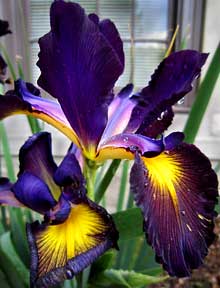 I looked away from the flashy beds of bearded irises and saw this glowing iris growing in a small bed on opposite the beardeds. It’s named ‘Missouri Iron Ore’ and is labeled spuria iris. The Spuria Iris Society says spurias are taller than other irises and they’re beardless. Spurias also make good cut flowers and are widely used in floral arrangements because they'll look good for a week or more. Compared with the regular bearded irises the spurias look as if they’ve had every bit of bloatedness wrung out of them leaving behind just slimmed down elegance. I looked away from the flashy beds of bearded irises and saw this glowing iris growing in a small bed on opposite the beardeds. It’s named ‘Missouri Iron Ore’ and is labeled spuria iris. The Spuria Iris Society says spurias are taller than other irises and they’re beardless. Spurias also make good cut flowers and are widely used in floral arrangements because they'll look good for a week or more. Compared with the regular bearded irises the spurias look as if they’ve had every bit of bloatedness wrung out of them leaving behind just slimmed down elegance.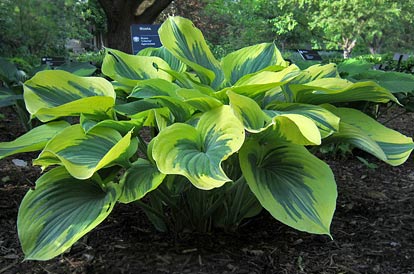 I found ‘Liberty’ this morning in the botanical garden. It was under a crab tree with scores of other newly planted hostas. I was looking for it both because a hosta grower friend of mine told me it was stunner and because it was named hosta of the year by the American Hosta Growers Association. The AHGA says their top award goes to a hosta that has a good chance of doing well in most parts of the county and is widely available at a reasonable price.  While they don’t mention looks, I’m betting that plain green, ordinary sized, nothing special varieties need not apply. Stands to reason that growers of hostas would need push varieties with enough sizzle to get buyers to pull their credit cards out. ‘Liberty’ has that pull – dramatic, wide buttery-cream margins that define shapes that look like palm leaves. The AHGA says that as the season wears on, the cream will turn to white. When mature, ‘Liberty’ will be a couple of feet tall and will form a clump about five feet across. The flowers, says a grower who has a Liberty, are “nothing special” – the usual pale lavender tubes. While they don’t mention looks, I’m betting that plain green, ordinary sized, nothing special varieties need not apply. Stands to reason that growers of hostas would need push varieties with enough sizzle to get buyers to pull their credit cards out. ‘Liberty’ has that pull – dramatic, wide buttery-cream margins that define shapes that look like palm leaves. The AHGA says that as the season wears on, the cream will turn to white. When mature, ‘Liberty’ will be a couple of feet tall and will form a clump about five feet across. The flowers, says a grower who has a Liberty, are “nothing special” – the usual pale lavender tubes. With most hosta growers it’s all about the leaves – big ones, small ones, patterned ones, glossy ones, blue ones. Flowers and scapes – not so much. Some think they’re boring; some find them so distracting that they cut them off as soon as they appear. This morning I saw this hosta with ho-hum seen that before leaves, but with a remarkable scape and with flowers coming from a place unknown to most hostas. The hosta is ‘Katie-Q.’ It has unremarkable green leaves fringed with washed out-looking cream margins. But what’s interesting about Katie-Q is the scape that sprouts leaves as it rises and ends with a pinwheel of leaves on top. Best though are its white flowers that poke out from its leaf axils. With most hosta growers it’s all about the leaves – big ones, small ones, patterned ones, glossy ones, blue ones. Flowers and scapes – not so much. Some think they’re boring; some find them so distracting that they cut them off as soon as they appear. This morning I saw this hosta with ho-hum seen that before leaves, but with a remarkable scape and with flowers coming from a place unknown to most hostas. The hosta is ‘Katie-Q.’ It has unremarkable green leaves fringed with washed out-looking cream margins. But what’s interesting about Katie-Q is the scape that sprouts leaves as it rises and ends with a pinwheel of leaves on top. Best though are its white flowers that poke out from its leaf axils. Sharp Dressed Man’ – the same name for two different plants. First there’s a purple iris with silken almost black falls accentuated with cravats of bright orange. Then there’s the sharp dressed hosta in green wearing a western-style cream bolo tie that's anchored with an eagle medallion. Another take on last week's notes about the newly replanted rose garden: Perhaps all of the roses in the major display garden were removed because some plants were infected with a highly contagious disease – the Rose Rosette Disease (RRD). The disease is thought to be caused by some still unknown pathogen carried by wingless mites so tiny that they can be spread by currents of air. Once the pathogen carried by the mites infects the plants, the bushes develop stunted, red shoots and long side branches that end in bundles of tiny twigs called witches brooms. The flowers may never bloom or if they do they may be deformed. The disease is fatal. There’s no known prevention nor cure. Rose Rosette Disease is rampant among multiflora roses, the ‘Ramblin’ Roses that Nate King Cole used to sing about. From the 1930’s though the 1960’s experts touted multiflora roses for everything from erosion control on hillsides and strip mines to fences for cattle and crash barriers for highways. The problem was that multiflora roses got out of control. They spread so rapidly that they are now crowding out native plant species and taking over crop land. As multiflora roses spread so does Rose Rosette Disease. While the disease is doing its best to wipe out the invasive multiflora roses, it is also spreading to the more gentile kind of ornamental roses planted in this botanical garden. Three years ago Rose Rosette Disease infected the rose garden at Scott Arboretum at Swarthmore College. The keepers of that garden decided to rip out all of the infected roses and replace them with marigolds for the rest of the season. The next year they replanted the garden with varieties that were more disease resistant and less dependant on chemicals. They chose Earthkind Roses, Kordes roses and Texas Pioneer Roses, all types of roses that are less demanding of care and have good disease resistance. So except for laying off a season by growing marigolds, the renewal at Scott’s rose garden looks much like the one just completed here at this botanical garden. Disease has become the catalyst for renewal. An aside: A bulletin from the Missouri Department of Conservation on Rose Rosette Disease mentioned that the disease also infects plum trees. This morning we noticed that the plum tree planted in the Ottoman garden that’s just north of the Rose Garden is dying. 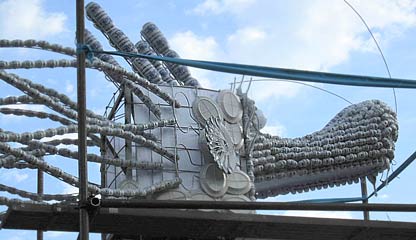 This summer’s big event is the Chinese Lantern Festival. The botanical garden brought in a team of artisans from Zigong, the home of lantern festivals in China for nearly 1500 years, to make 26 giant lanterns from scratch. Inside tents set up in the parking lot, the artisans are welding iron rods into skeletal frames for the lanterns. The frames are then being draped with colorful swaths of silk that are attached with gold trim. When the lanterns are complete, they will be lit from the inside or they will be draped with ropes of light. The botanical garden is billing the festival as “Art by Day, Magic by Night.” To preview what the display here might look like, have a look at these wonderful nighttime pictures of the Lantern Festival held in Zigong last February.  This morning I saw start of the of the installation here – a welder attaching a dragon’s head to its undulating body of iron rods. This morning I saw start of the of the installation here – a welder attaching a dragon’s head to its undulating body of iron rods. Few of us have the stomach to rip out all of the roses we’ve bought and planted and babied over the years. But that’s what was done in the rose garden at this botanical garden. The rose garden has more that sixty separate beds arranged like a wagon wheel with a fountain as its axle. It’s been in this location since 1917 and before all of plants were removed it had about 1,315 roses representing 105 varieties of hybrid tea, shrub and floribunda roses. They were all taken out and replaced with new young plants. Of the thousands of possible roses that the keepers of this garden could have chosen to plant here, which did they choose and why did they choose them? To get a better idea of what, which, and why, I walked around the new planted rose garden snapping pictures of some of the name tags dangling from the young rose canes. I noticed several things about the new roses. First many of them came from just one nursery – Chamblee Rose Nursery, a family owned rose grower in the Tyler, Texas, the self-proclaimed rose growing capital of the world. Chamblee’s moto is “Environmentally friendly roses for environmentally responsible people.” They feature Dr. Griffith J. Buck roses and “Earthkind” roses. Lots of both types were planted here. Buck roses are bred to be disease resistant and to take care of themselves without spaying in the summer or mounding in the winter. From the Buck collection I saw ‘Prairie Harvest,’ ‘Silver Shadows,’ 'Quietness' and ‘Summer Honey.’ The “Earthkind” label is a seal of approval given to roses that survive eight years of research and field testing for resisting pests, shrugging off poor soil, and surviving heat and drought and still look marvelous. The Earthkind varieties I saw were ‘Caldwell Pink,’ ‘Georgetown Tea,’ ‘Sea Foam,’ and ‘Knockout.’ So what’s changed? Roses that throw temper tantrums will no longer be tolerated or welcomed here. Rosarians used to catering to the every whim of their spoiled children will have less do. This new community of roses will look after itself without constantly being coddled and cajoled to bloom with offer of pesticides, fertilizers, and water. Sustainable practices seems to be the watchword for this new garden. What remains to be seen though is how this new community of sustainable roses will perform. Visitors come to a rose garden to be awed by beauty and scent not to be impressed with sign that proclaim how tough and enviornmentally friendly some bush it might be. 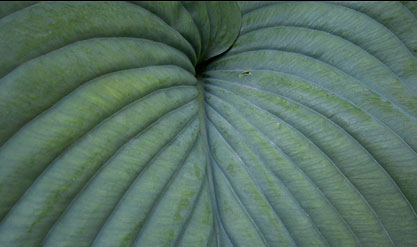 Extremes draw attention – the very large, the tiny: Who doesn’t stop for a closer look? This morning I decided that I’d look at oversized hostas. A hosta grower friend of mine told me that big is better this year in part because the American Hosta Society choose a large hosta named ‘Liberty’ as the 2012 Hosta of the Year. 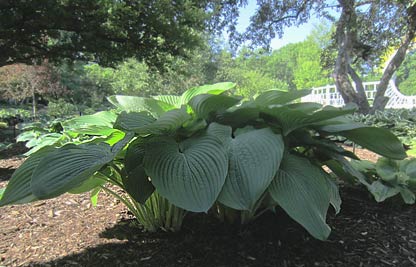 I couldn’t find “Liberty’ in the botanical garden, but did see this giant named ‘Empress Wu.’ -- named in honor of the only female emperor of China. I found that the ‘Empress Wu’ hosta has it’s own website complete with video, pictures, and lure. Wu’s stats are impressive. It’s leaves are a foot and a half to two feet across. Clumps mature to four-feet tall and five across. Scapes grow to be five-feet tall. Unlike many of the other large hostas that look like over-sized marshmallows plumped on the ground, ‘Empress Wu’ has an elegant vase shape that forms a canopy over the ground. 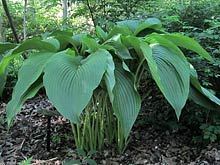 Big, but not quite as big as ‘Empress Wu’ is my favorite among the large hostas: ‘Jade Cascade.’ Look for a several mature clumps of them growing along one of the unpaved walks in the English Woodland Garden. ‘Jade’ too forms clumps that are five feet across and grows three feet tall. But what makes ‘Jade Cascade’ my favorite is its tapered deeply veined leaves held high on its leaf stocks. The effect is like rivulets of flowing water.
Big, but not quite as big as ‘Empress Wu’ is my favorite among the large hostas: ‘Jade Cascade.’ Look for a several mature clumps of them growing along one of the unpaved walks in the English Woodland Garden. ‘Jade’ too forms clumps that are five feet across and grows three feet tall. But what makes ‘Jade Cascade’ my favorite is its tapered deeply veined leaves held high on its leaf stocks. The effect is like rivulets of flowing water.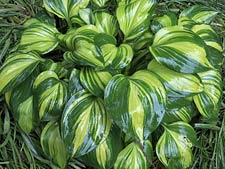 Switching to regular-sized hostas for a minute: on the recommendation of a friend I bought a pot of hostas named ‘Rainbow’s End’ at a local nursery. My plants are still very young, so it’s hard for me to image what they will look like when they grow up. Hoping that the botanical garden would have a mature specimen, I checked their hosta beds this week. Here’s a mature ‘Rainbow’s End.’ Just when I think hostas breeders can’t do much more with the plant’s leaves, another even more striking, dramatic variety appears. Glossy leaves that look lustrous and buttery when wet; Rembrandt tulip markings make me pause to have a closer look; leaf colors with shades of green, lime, and cream that interlace. If hostas continue to get any better, the line between real plants and artificial ones will get so blurred that hosta-lovers will start shopping at Michael’s. Switching to regular-sized hostas for a minute: on the recommendation of a friend I bought a pot of hostas named ‘Rainbow’s End’ at a local nursery. My plants are still very young, so it’s hard for me to image what they will look like when they grow up. Hoping that the botanical garden would have a mature specimen, I checked their hosta beds this week. Here’s a mature ‘Rainbow’s End.’ Just when I think hostas breeders can’t do much more with the plant’s leaves, another even more striking, dramatic variety appears. Glossy leaves that look lustrous and buttery when wet; Rembrandt tulip markings make me pause to have a closer look; leaf colors with shades of green, lime, and cream that interlace. If hostas continue to get any better, the line between real plants and artificial ones will get so blurred that hosta-lovers will start shopping at Michael’s. The Yellow Lady’s Slipper orchid (Cypripedium calceolus) has a full page spread in the field guide Missouri Wild Flowers. The orchids are supposed to bloom in late spring at the tops of wooded slopes in this part of the state. Yet in all of the spring flower walks I’ve taken over the years, I’ve only seen a patch of them once. Maybe they're so rare and unusual that when they’re spotted, many people can’t settle for just taking a picture of them. It was nice to see them in bloom again here in the English Garden. The Yellow Lady’s Slipper orchid (Cypripedium calceolus) has a full page spread in the field guide Missouri Wild Flowers. The orchids are supposed to bloom in late spring at the tops of wooded slopes in this part of the state. Yet in all of the spring flower walks I’ve taken over the years, I’ve only seen a patch of them once. Maybe they're so rare and unusual that when they’re spotted, many people can’t settle for just taking a picture of them. It was nice to see them in bloom again here in the English Garden. |
||||||||||||||||||||||||||||||||||||||||||
|
+ Click to Subscribe
 | E-Mail me | E-Mail me |
|||||||||||||||||||||||||||||||||||||||||||